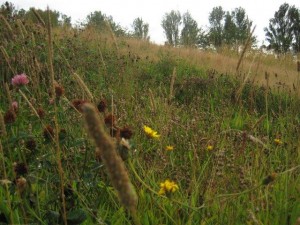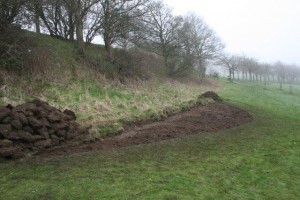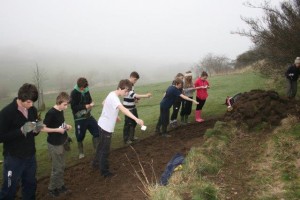Work is underway to enhance the habitat in Braidburn Valley Park to provide suitable haunts for bumblebees. These bees, that we are all familiar with, have very specific requirements for both nesting and feeding. Bumblebees are becoming increasingly scare in Britain as the habitat they require is lost. Areas such as parks and gardens can provide a refuge for them. There are 5 or 6 species of bumblebees that frequent the Park and all these can be seen in the early summer feeding on the existing wildflower meadow at the south east end of the Braidburn Valley Park created over 6 years ago (see Bumblebee Conservation trust for lots of information on bumblebees).
It may be surprising but Bumblebees, like most birds, start breeding very early in the year. The queens emerge from hibernation and begin searching for a nest site in late Feb or early March depending on the weather and species. They mostly nest underground and excavate small burrows in loose soil or take over existing holes made by mice or voles. As well as nesting sites their other main requirement is energy! They need nectar and pollen from early flowers such as Willow and Primroses or else they will starve and be unable to create a nest and lay their eggs. By July it is all over with the new queens hibernating for the winter in August.
For details about the existing wildflower meadow see the Friends of Braidburn Valley website
To complement the existing wildflower meadow created over 6 years ago the Friends group are now creating 2 new smaller areas of wild flowers on the east side of the Park.
The first is at the base of the embankment below Comiston Road. This area had the turf removed by the Green Team at the end of March and was sown with a wildflower mix. Plug plants of perennial species will be added in the next few months. The old turfs have been used to create 2 small mounds and their loose structure will provide nesting sites for the bees as well as an area for wildflowers such as Vipers bugloss and Thyme.
The second area is the old rose bed alongside Comiston Road near the old tram shelter. The Council removed the old roses last winter and offered the bed to the Friends group to transform into a nectar heaven for bees. We will be helped by students from Edinburgh University as part of their Edinburgh University Global Environment, Politics and Society MSc programme. Again we will use a mixture of seed and plug plants to create the bee habitat ensuring we have plants to provide that all important early nectar.
The turf is removed to reduce the soil fertility and therefore the vigour of grass which would out compete the flowers we are trying to encourage. To reduce the vigour of the grass further we will sow a plant called Yellow Rattle (so named because the seeds rattle on the plant when ripe in the autumn) which is parasitic on the grass roots. This has been very successful in the original wildflower meadow. If you look at the grass in summer you can see the height of the grass visibly reduced where the Yellow Rattle is growing.
Next time you are in the Park take a walk up to the south east corner to see the new and old wildflower meadows. Hopefully you will spot bumblebees buzzing around but don’t leave it too late as winter starts again in August!




